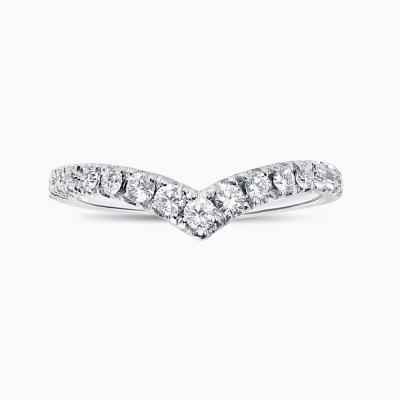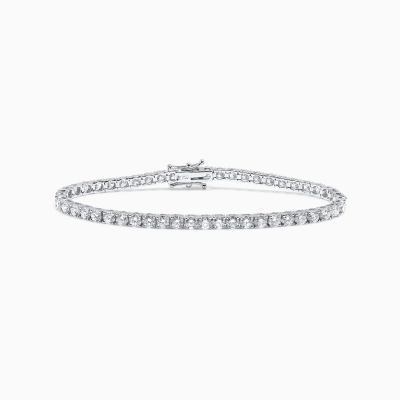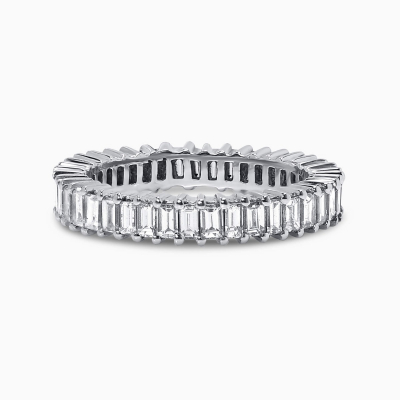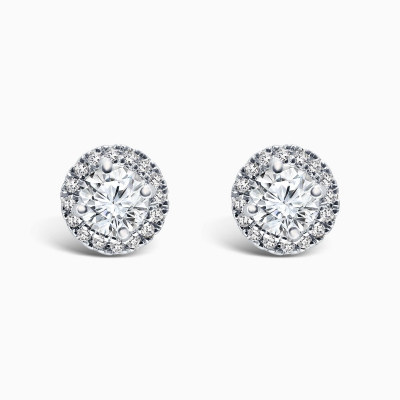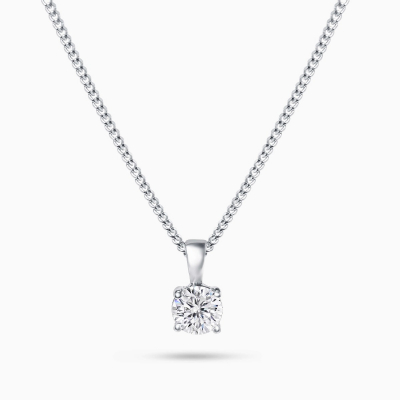USD
/
USD
/
Shipping to:
Currency:
EMERALD CUT DIAMONDS
Emerald Cut diamonds, not to be confused with the green gemstone itself, is a very unique diamond cut that is unlike any other. It draws its uniqueness from the fact that unlike other brilliant cut shapes such as rounds or ovals, the scintillation pattern of an Emerald Cut diamond is totally different, and it is actually a step cut.
This means that within an Emerald Cut diamond there are small rectangular facets arranged in a parallel setting which look like steps, a total contrast to the traditional star and kite shaped facets of other brilliant cuts.
Emerald Cut diamonds became very popular during the Art Deco era. Their enduring popularity even today sees them as the diamond of choice for those looking for a show stopping ring. Not only do they exhibit brilliance and sparkle, albeit in a slightly more muted fashion than some other cuts, but the elegant long body of these diamonds has the effect of making them look larger than diamonds of a similar carat in other cuts. Here we take a close look at the beauty of Emerald Cut diamonds.
01
THE HISTORY OF EMERALD CUT DIAMONDS
The Emerald Cut was first developed as far back as the 1500s and its origin explains where this cut derives its name from. Stonecutters developed the shape within emerald stones as it proved to be able to reduce pressure during the process of cutting, so lessening the risk of any chips occurring in the Emeralds. Diamond cutters noticed this factor and from this the Emerald Cut in diamonds was created. However, it was not until the Roaring Twenties and the Art Deco period that Emerald Cut diamonds became popular within pieces of diamond jewelry. The style of this opulent era focussed upon symmetry and clean lines and the Emerald Cut perfectly reflects this design style.
02
CHARACTERISTICS OF EMERALD CUT DIAMONDS
Emerald Cut diamonds belong to the ‘step cut’ family of diamond cuts. This term is derived from the positioning of the facets that when viewed from above look like steps, with three rows of steps above and three below the stone. The 57 facets of an Emerald Cut diamond are divided into 8 on the girdle, 25 on the top, and 24 at the bottom of the diamond. They also have blocked corners which add to their distinctive appearance.
Emerald Cut diamonds most commonly take on a rectangular shape due its ratio of 1.5 which means that they exhibit a larger than average table which enables viewers to see far into the diamond. Therefore, any inclusions or flaws or color inconsistencies within the diamonds will be clearly seen, meaning that high quality purity and color are essential within an Emerald Cut diamond.
Due to its step cut, Emerald Cut diamonds do not bend or tend to reflect as much light as Round Cut diamonds but creates the effect of a hall of mirrors. This not only leads to a loss in brilliance and scintillation, but also contributes to the inability of this cut to hide flaws.

03
PROS AND CONS OF EMERALD CUT DIAMONDS
PROS
- Emerald Cut diamonds are more affordable than Brilliant Cuts, in fact on average this can be as much as 35% lower in price. This is due to the fact that they are less in demand and show less brilliance. This factor does make Emerald Cut diamonds the perfect choice in comparison to Brilliant Cut diamonds if you are working to a strict budget yet naturally still want a head turning timeless engagement ring or piece of diamond jewelry.
- Emerald Cut diamonds create the illusion of looking larger than other diamond cuts of the same carat weight due to their wider surface area. In particular, Emerald Cuts often look larger than Round Brilliants. So for example, a round cut one carat diamond will measure 6.5mm whereas a once carat Emerald Cut can measure 7.5mm. This is of great advantage to those buyers who wish to purchase a larger size diamond without the higher carat price tag!
- As Emerald Cut diamonds have their corners cropped to form a smooth diagonal edge, they do not catch as easily on clothing, seating or other close contact item. This also means that unlike diamonds with sharp corners, Emerald Cut diamonds are more able to withstand the wear and tear of everyday life, and are not as vulnerable to coming away from their setting or getting chipped. This makes Emerald Cut diamonds a great choice for those with an active lifestyle.
- The Emerald Cut diamond is a very versatile gemstone. It makes both a stunning focal point in a solitaire setting and sits well with accents in contrasting cuts such as pave or channel settings and these add to its beauty giving the diamond more brilliance.
- This cut of diamond is very complimentary in making fingers look slimmer as it elongates the fingers in a way other cuts cannot achieve.
CONS
- Emerald Cut diamonds are renowned for not hiding any inclusions such as feathers, cavities, etch channels or/and twinning wisps. The reason for this being that Emerald Cut diamonds do not reflect as high a level of light as brilliant cuts, and it is this light that hides inclusions. To overcome this disadvantage look for an eye clean Emerald Cut diamond with a clarity grace of VS2 and above.
- The Emerald Cut has a tendency to show more color. As we know, the color grading of diamonds is a reference to the presence of brown or yellow tints. To appear to the naked eye to be colorless, Emerald Cut diamonds require a higher color grade in comparison to brilliant cuts. To avoid this chose and Emerald Cut of H grade color.
- In comparison to brilliant cuts such as Princess, Cushion or Round, and Emerald Cut diamond will display less brilliance. The reason for this is that these other diamond cuts are designed to maximize light refraction and have a higher number of facets which capture and reflect light. Emerald Cut diamonds exhibit the effect of a hall of mirrors so produce less sparkle in comparison.
- There is no cut grade provided by the GIA in the way that it grades color and clarity with fancy shapes, and this includes Emerald Cut diamonds. To replace this the GIA grades Emerald Cut diamonds on factors such as the qualities that constitute the cut. These include polish and symmetry, girdle thickness, and overall measurements of the diamond.
04
DO EMERALD CUT DIAMONDS REPRESENT GOOD VALUE FOR MONEY
In the cutting process, the Emerald Cut diamond uses a significant percentage of the rough diamond which means that it represents good value for money.
Additionally, as Emerald Cut diamonds have a 5% greater surface area, they give the appearance of being larger than a comparable diamond of an equivalent carat weight in another cut such as the Round. Therefore, for those buyers looking for an absolutely stunning diamond on a budget this is a major plus factor, as you will be able to buy a smaller diamond so saving money but still get the wow factor.

WHERE NEXT?
Looking to buy a round loose diamond?
Book a visit to our New York or Los Angeles showrooms or search through our diamonds inventory online.
Contact us:+1 (646) 898 2098

WHERE NEXT?
Looking to buy a round loose diamond?
Book a visit to our New York or Los Angeles showrooms or search through our diamonds inventory online.
Contact us:+1 (646) 898 2098







